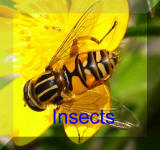Acorn Cup Galls Andricus grossulariae
Hymenoptera: Cynipidae
Andricus fructuum , Andricus gemellus , Andricus intermedius Andricus mayri and Cynips panteli
Description
Acorn cup galls develop as a chemically induced distortion of the growing acorn cups on oak trees, caused by gall wasps which lay eggs within the tissues of the acorn cup.
The sexual phase appears on catkins as rounded structures (6 mm × 3–4 mm) possessing a characteristic point, and when young are covered with fine hairs. The galls, shiny and hard, turn red in colour and then black or dark purple.
The asexual or parthenogenetic phase, about 10 mm across,develops on acorn cups of English oak Q. robur and sessile oak Q. petraea. The galls, formed of flattend projections, often enclose the immature acorn. The galls first appear pink in colour and as they mature they turn red, then green and finally brown during their development. Previously the causer of this stage was known as Andricus mayri
The Gall Appearance
A. grossulariae, although usually found on acorns, is also found on buds. Normally distinctive the asexual acorn cup gall can, under some growth conditions, be mistaken for the knopper gall, caused by the gall wasp Andricus quercuscalicis
Habitat
"Andricus grossulariae asexual from Quercus robur 3" by Quentin Groom - Own work. Licensed under CC BY 1.0 via Wikimedia Commons.

